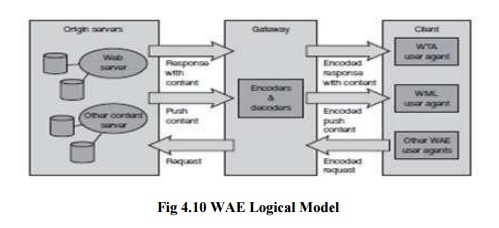Chapter: Mobile Networks : Transport and Application Layers
Wireless Application Environment
Wireless Application Environment
The main
idea behind the wireless application environment (WAE) is to create a
general-purpose application environment based mainly on existing technologies
and philosophies of the world wide web. This environment should allow service
providers, software manufacturers, or hardware vendors to integrate their
applications so they can reach a wide variety of different wireless platforms
in an efficient way. However, WAE does not dictate or assume any specific
man-machine-interface model, but allows for a variety of devices, each with its
own capabilities and probably vendor-specific extras (i.e., each vendor can
have its own look and feel). WAE has already integrated the following
technologies and adapted them for use in a wireless environment with low power
handheld devices.
HTML,
JavaScript, and the handheld device markup language HDML form the basis of the
wireless markup language (WML) and the scripting language WML script. The
exchange formats for business cards and phone books vCard and for calendars
vCalendar have been included. URLs from the web can be used. A wide range of
mobile telecommunication technologies have been adopted and integrated into the
wireless telephony application (WTA).
Besides
relying on mature and established technology, WAE focuses on devices with very
limited capabilities, narrow-band environments, and special security and access
control features. The first phase of the WAE specification developed a whole
application suite, especially for wireless clients as presented in the
following sections. Future developments for the WAE will include extensions for
more content formats, integration of further existing or emerging technologies,
more server-side aspects, and the integration of intelligent telephone
networks.

One
global goal of the WAE is to minimize over-the-air traffic and resource
consumption on the handheld device. This goal is also reflected in the logical
model underlying WAE (Figure 10.29) showing some more detail than the general
overview in Figure 10.10. WAE adopts a model that closely follows the www
model, but assumes additional gateways that can enhance transmission
efficiency.
A client
issues an encoded request for an operation on a remote server. Encoding is
necessary to minimize data sent over the air and to save resources on the
handheld device as explained together with the languages WML and WMLscript.
Decoders in a gateway now translate this encoded request into a standard
request as understood by the origin servers. This could be a request to get a
web page to set up a call. The gateway transfers this request to the
appropriate origin server as if it came from a standard client. Origin servers
could be standard web servers running HTTP and generating content using
scripts, providing pages using a database, or applying any other (proprietary)
technology. WAE does not specify any standard content generator or server, but
assumes that the majority will follow the standard technology used in today‘s
www.
The
origin servers will respond to the request. The gateway now encodes the
response and its content (if there is any) and transfers the encoded response
with the content to the client. The WAE logical model not only includes this
standard request/response scheme, but it also includes push services. Then an
origin server pushes content to the gateway. The gateway encodes the pushed
content and transmits the encoded push content to the client.
Several
user agents can reside within a client. User agents include such items as:
browsers, phonebooks, message editors etc. WAE does not specify the number of
user agents or their functionality, but assumes a basic WML user agent that
supports WML, WML script, or both (i.e., a ‗WML browser‘). Further domain
specific user agents with varying architectures can be implemented. Again, this
is left to vendors. However, one more user agent has been specified with its
fundamental services, the WTA user agent. This user agent handles access to,
and interaction with, mobile telephone features (such as call control). As over
time many vendor dependent user agents may develop, the standard defines a user
agent profile (UAProf), which describes the capabilities of a user agent.
Capabilities may be related to hardware or software.
Examples
are: display size, operating system, browser version, processor, memory size,
audio/video codec, or supported network types. The basic languages WML and WML
Script , and the WTA will be described in the following three sections.
Related Topics